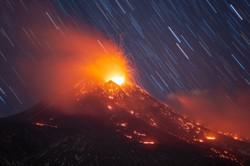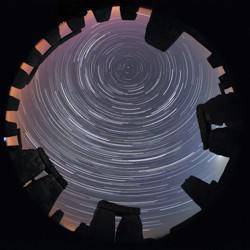Glossarbegriffe: Strichspuraufnahme
Description: In der Astrofotografie sind Strichspuraufnahmen auffällige Bilder des Nachthimmels bei sehr langen Belichtungszeiten. Der Grund dafür ist die Drehung der Kamera mit der Erde: Die Sterne scheinen sich über den Nachthimmel zu bewegen, was zu Strichspuren auf den Bildern führt. Wenn die Kamera auf den Nord- oder Südpol des Himmels gerichtet ist, bilden die Spuren Halbkreise, die auf die Polposition am Himmel zentriert sind. Strichspurenaufnahmen können auch durch eine Reihe von Kurzzeitbelichtungen erstellt werden, die dann in einer Bildbearbeitungssoftware übereinander gelegt werden. Manchmal verwendet man für Strichspuraufnahmen auch ihre englische Bezeichnung: Startrails.
Zugehörige Glossarbegriffe:
See this term in other languages
Term and definition status: The original definition of this term in English have been approved by a research astronomer and a teacher The translation of this term and its definition is still awaiting approval
The OAE Multilingual Glossary is a project of the IAU Office of Astronomy for Education (OAE) in collaboration with the IAU Office of Astronomy Outreach (OAO). The terms and definitions were chosen, written and reviewed by a collective effort from the OAE, the OAE Centers and Nodes, the OAE National Astronomy Education Coordinators (NAECs) and other volunteers. You can find a full list of credits here. All glossary terms and their definitions are released under a Creative Commons CC BY-4.0 license and should be credited to "IAU OAE".
Zugehörige Medien
Star Trails And Lava Plume on Mount Etna February 2021, by Dario Giannobile, Italy
Bildnachweis: Dario Giannobile/IAU OAE
License: CC-BY-4.0 Creative Commons Namensnennung 4.0 International (CC BY 4.0) icons
Stone Star Circles, Startrails above Stonehenge, by Till Credner, Germany
Bildnachweis: Till Credner/IAU OAE
License: CC-BY-4.0 Creative Commons Namensnennung 4.0 International (CC BY 4.0) icons
Half day exposure to the north star, by Fabrizio Melandri, Italy
Bildnachweis: Fabrizio Melandri/IAU OAE
License: CC-BY-4.0 Creative Commons Namensnennung 4.0 International (CC BY 4.0) icons











